#zendikar lore
Explore tagged Tumblr posts
Text
A quick summary of the MTG cookbook that dropped yesterday:
Ravnica: Krenko got hired by Jace to gather one recipe from each of the ten guilds.
Dominaria: Asmoranomardicadaistinaculdacar travels Dominaria looking for cool mortal fare for her new cookbook.
Eldraine: Storytelling with the Kenriths, Garruk, and Oko involved.
Innistrad: Tibalt being a little slut who is getting in the middle of everything.
Kaldheim: Tyvar preparing a feast for the valkyries to impress them. Also Toski helps.
Kamigawa: Recipes left by Tamiyo to her family, complete with stories that go with them.
Theros: Xenagos starts daydreaming about a new planeswalker pantheon.
Zendikar: Bruse Tarl driving his herds all over Zendikar and picking up meals from everywhere.
Kaladesh: Chandra reminiscing on her life on Kaladesh, featuring Saheeli and Huatli.
Ixalan: The culinary adventures of Vraska and Jace while they were looking for the Immortal Sun.
#jasper post#magic the gathering#ravnica#dominaria#innistrad#eldraine#kaldheim#kamigawa#theros#zendikar#kaladesh#ixalan#cuisines of the multiverse#magic the gathering: cuisines of the multiverse#cookbook#lore
72 notes
·
View notes
Text
Fatal Lore
Do card spikes help preserve the history of the game? Is that what is meant by fatal lore? Does the preservation of the history of the reserved list lead to recognition of older cards which in turn leads to buyouts and spikes? I ask these questions because I was looking into this card, fatal lore, and I found an article associated with it. On edhrec if you search this card an article from March 30, 2021 pops up. I was interested so I clicked on the article and, at first, I was a bit perplexed. The article was about a Yennett commander deck which revolves around cards with odd mana values. Fatal lore has an even mana value so I was interested in why they would suggest this card or use the card image in the article. I read it and there is one small section where an individual suggests a Yennett build that lets your opponent make choices but does not suggest this exact card. I wondered why use this image instead of many other odd mana cost cards that force your opponent to make a choice. Then I looked at the date of the article. At first, I thought that the use of the image was an attempt to spike the reserved list or manipulate the market in some way. This was around the time of the great reserved list spike in which almost all reserved list cards went up in price and buyouts were a common occurrence. It just so happens that fatal lore reached its almost 6 dollar high on March 3, 2021. The card was in everyone's mind because it had spiked in the same month and the article writer saw a chance to include a currently very popular and discussed card into his article; maybe to gain traffic. After all, if everyone is talking about reserved list cards and buyouts shouldn't your articles try to include that to appeal to the current hype and draw a larger audience? Yet, that preserved the card fatal lore with an article. There is not much to say about the actual card but there is an article that uses this card's image and that is because for a very short window this card was hot. It also shows a snapshot of the history of the reserved list. The card, itself, is not terrible. You either draw 3 cards or you destroy two of your opponent's creatures and they draw 3. If you are playing Sheoldred the Apocalypse then you can change that drawback into a reward. Forcing your opponent to draw is a popular strategy with cards like underworld dreams and Nekusar. Of course, your opponent will likely just let you draw 3 cards if drawing the cards will hurt them that much. Also, soemtimes your opponent just has an army of tokens and then this card becomes less effective. 4 mana for a draw 3 in black is fine but there are just so many cards printed and there is just not a perfect home for this card. If they ever make a commander that benfits from your opponent choosing and also benefits from drawing cards in some way than this card may finally find a place. Until then, this card is just fatal lore.
#magic the gathering#magic the card game#youtube#commander legends#mtg#commander#blogatog#arena#mark rosewater#reserved list#fatal lore#alliances#mtg arena#mtgstocks#mtg commander#mtgo#edh#edhrec#magic card game#maro#magic the gathering arena#magic arena#mtg zendikar
6 notes
·
View notes
Text
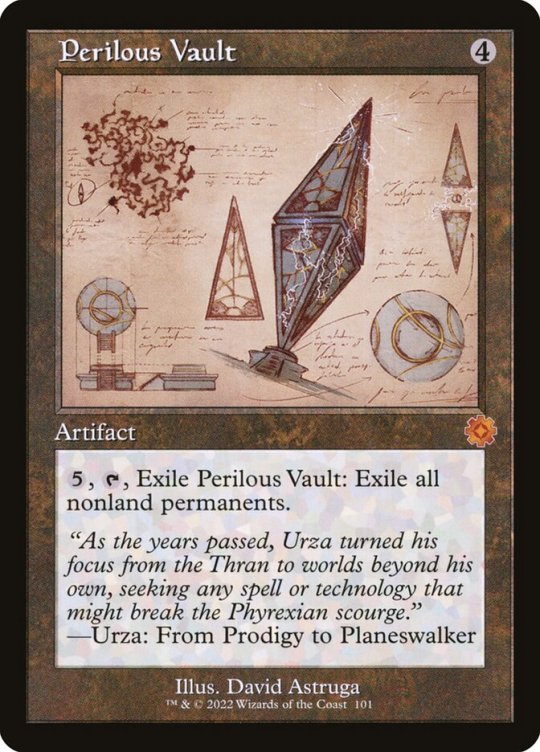
My kingdom for the short story where Urza comes to zendikar and gets shooed off by nahiri
#in general i just think more stories that tie together the pasts of planes and old lore would be cool#another zendikar/dominaria connection is the kor in general via rath. would LOVE to see that come to something more#mtg
2 notes
·
View notes
Note
I wanted to tell you one of my favorite things about Magic, lore/flavor wise. I love how on each world, many things look different. The angels on Zendikar mostly have multiple sets of wings, whereas Ravnica they mostly don't. Ixalan dinosaurs have feathers, but Muragandan ones don't. Dragons on Innistrad are skinnier and have see-through wings, whereas on Ravnica they look more like classic dragons. It's so fascinating to be able to tell different planes from differences in the art of creatures.
Our creative team spends a lot of time giving each world, and its inhabitants, a distinctive look.
249 notes
·
View notes
Text
Roilmages are cool :)

“…And if you look through the ice, you can see the-”
“The different colors, yeah! Like a rainbow!”
Noyan Dar bristled at the other merfolk’s rather pedestrian description. “Well, technically it’s dubbed the prism array. But yes, Isanke, the array does look somewhat like a rainbow.”
“I knew it.” Isanke smirked, then pointed to the Eldrazi frozen within the prism. “So, uh, what’s it supposed to do, besides freezing those things?”
“Freezing them is all it is supposed to do.”
“Oh, nothing more?”
Noyan rolled his eyes. “And what more could you want, of ice?”
“Well…maybe a weapon?”
“Wh- It is a weapon!”
“No, it just froze the thing. But it’ll be thawed in…well, it looks like just a few minutes.”
“Don’t be absurd- Oh, hmm!”
Noyan startled at the sight of rapidly melting ice. He backpedaled furiously to hide behind Isanke, who was now trying and failing to stifle her laughter.
“W-Well,” spat the older merfolk, “so mine wasn’t a permanent solution! I’d like to see you do better!”
Isanke shrugged and stepped forward. She took a deep breath, channeled her magic, then placed a hand to the ice. It shattered immediately, freeing the Eldrazi and sending Noyan into an even deeper panic.
“Isanke!”
“Oh, calm down!” Isanke wore a smile as she gestured towards the melting shards lying on the ground. The remaining ice hovered into the air, wavering briefly in place before angling up and spearing the Eldrazi many times over. Finally it stopped its writhing, much to Noyan’s relief and irritation alike.
“Well…I suppose that worked, this time,” groaned the older merfolk. “But I definitely wouldn’t rely on that all the time.”
Isanke shrugged. “Just as well, ‘unpredictable weather’ and all!”
Noyan’s face grew stern again. “‘Weather’!” he parroted.
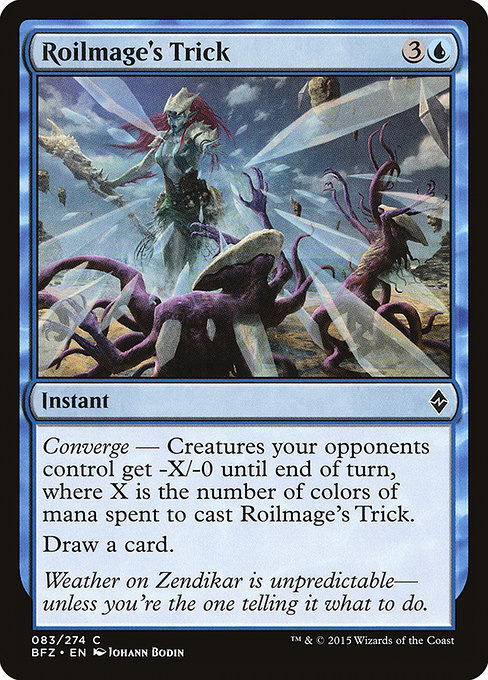
[To me, Roilmage’s Trick’s name and effect imply like just a distraction or a delay or something. But then there’s the art which definitely depicts a more forceful approach.]
10 notes
·
View notes
Text
RE: Nissa’s Retcon
* * *
About once a month, I get a comment on one of my posts saying something along these lines
“Uhhh, you left out the part where Nissa was a fascist!”
“Nissa was more interesting as an elf-supremacist, imo.”
To be perfectly frank, I think both of these points are stupid and not worth my time, but just to give these posters the benefit of the doubt, I’ll assume they mean well and respond to them, once and for all, this way:
To address the first point, you’re right: in my posts celebrating Nissa and the journeys she has taken, I do tend to leave out material that was retconned. This isn’t entirely true, however, as I wrote an entire essay about this on my Tumblr page, which I doubt people slipping into my comments to post “gotcha!” have bothered to read. But anyway, to assume the best of these posters, let’s take a brief look at this retcon. Outside of a few brief blurbs in the “Duels of the Planeswalkers” video game and her 2009-era character description on Magic’s website, the “racist Nissa” characterization comes entirely from the In the Teeth of Akoum novel from 2010. And yes! In this book, Nissa is a hilariously stupid racist (frighteningly like real racists, imo). However, many aspects of this book were retconned in Nissa’s Magic Origins reboot. To note, in the 2010 novel, Nissa has no idea what the fuck Akoum even is and lets herself get led there by Sorin and Anowon. In the reboot, we learn that, among many other changes, she went to Akoum previously in her life, as that journey is what led to her sparking. Either way, post-Origins, many aspects of Teeth are questionably accurate at best. It’s quite safe to assume that with how horrified Nissa is when she sees Lorwyn elves hunting goblin children for sport that that particular aspect of Nissa’s personality (white supremacy) is no longer a part of her characterization.
For the second point, this one is just crazy, man. I don’t know y’all come up with this stuff. I don’t even know how to address this politely. Keep in mind that I am not by any stretch saying that Nissa is now a perfect cinnamon roll that never did anything wrong ever. Nissa is at fault for not trusting Sorin and setting the Eldrazi free. This is a decision that forever will, and should, haunt her. In the newer lore, she still distrusts vampires and outsiders in her youth because of how she was raised, and this is wrong of her. But Nissa does not distrust them because she thinks she is somehow morally superior to them by nature of birth. Nissa was raised as a member of the Joraga nation. The Joraga, as even the most basic of searches into the Magic wiki tells us, “eschewed outsiders and held even the other elves of Zendikar in disdain.” Nissa carries this distrust of outsiders with her into her adult life and doesn’t really learn to let go of this until she meets the Gatewatch and learns to expand her horizons. And again, Nissa was wrong for this xenophobia. But don’t get it twisted: there is still a big difference between fear and distrust of outsiders and fascist, ‘hierarchy of races’ bullshit. Both are rooted in fear, but for all her many shortcomings, the retconned Nissa of the new lore would never advocate for elves ruling the multiverse at the top of a racial hierarchy like the older Nissa would (and did). This is hammered home in her Origin story where she is horrified by watching Dwynen lead other Lorwyn elves as they slaughter entire tribes because they think it's funny. Furthermore, on the subject of Lorwyn elves, I would argue that old Nissa is fairly boring as a villain, as “racist elves” as a concept was already explored in depth in the Lorwyn stories. An entire planeswalker with that as her bit would get boring very quickly.
Lastly, and I suppose this is subjective, but isn’t a nuanced character, deeply flawed but trying her best to shed the xenophobia ingrained in her more interesting that an unrepentant, racist dumbass learning that “goblins are people actually!” only after she condemned an entire world to death? The latter might be (darkly) funnier, I’ll give you that, but the former makes for a much more interesting and emotionally satisfying narrative arc.
84 notes
·
View notes
Note
How much of the "Sorin spends all his days moping around" stuff is legitimate versus just am internet meme?
This is a very good question, and I think the answer is that it really depends.
We are meant to believe that a Pre-Zendikar Sorin is actually a very active and busy person. He travels the multiverse to learn, explore, and generally act as a positive presence on the plane; we don’t know a lot of details about what exactly he did that was good, but his Planeswalker bio and several other lore documents want us to believe that he has a long history of helping other planes aside from Innistrad and Zendikar (as much as you can call what he did there “help”.
Sorin does avoid helping with a lot of the main conflicts for a lot of the Eldrazi arc though. He is still out doing things that could help (resurrecting Ugin for example), but he is very much on the side and not exactly improving the situation beyond that. During SOI he even acts as an active detriment to the saving of Innistrad by killing Avacyn (a good choice for her, but really bad for the people of Innistrad) and choosing to fight Nahiri instead of Emrakul, considering Innistrad a lost cause to be avenged. He is active and doing things, but they’re not always the most helpful-
A Post-War of the Spark Sorin is a very different story.
Sorin was left in a deep depression after the death of Avacyn, and spent the next two years grieving and sulking in the ruins of his family home. He did not do anything to stop eternal night from falling on Innistrad despite not actually wanting it to fall, and when The Gatewatch + Adeline and Arlinn came to ask him to lend them an artifact that would help them put a stop to it, he refused to allow them to borrow it and was very much unhelpful, even attacking Arlinn for mentioning Avacyn’s name. He actively tried to prevent them from doing something he wanted done.
By the time Crimson Vow rolls around (about one month after eternal night fell at the end of Midnight Hunt) Sorin seems to be motivated enough to at least ask his grandfather for advice on how to help the plane, and with the motivation of The Gatewatch and being forced to confront his past and the trauma that led him to that behavior to begin with he seems to develop into a character who does want to help people and do things again by the end of VOW.
We haven’t seen him on screen since the end of the wedding, but in that time he has gone out of his way to take the sick and injured into his home so he could care for them, team up with Arlinn Kord to prepare Innistrad for the Phyrexian invasion, and went out of his way to warn a few of the necromancers of Innistrad of the Phyrexians, possibly because of the undead’s resistance to the oil.
TLDR: Sorin was a very active character to both good and bad ends before Innistrad was invaded by Emrakul, but ended up in a grief induced sulk until the beginning of Crimson Vow (a set released five years after Eldritch Moon and taking place about 2 years after in universe) to the point where he would actively prevent other people from doing things that he wants done. I think the whole joke originates from that, and from the fact that Sorin has generally just proven not to always be the most helpful character around despite how insanely powerful he is and how much potential he has to help other people.
Thankfully it looks like Crimson Vow really did help him grow as a character, and it seems like he is going to be more helpful than ever before considering he finally has a support group and cut off his shitty family. What we have seen of him since then all looks to be a massive shift and character and it’s all looking up from here :D.
#mtg#sorin markov#vorthos#innistrad#please read crimson vow i beg of you#crimson vow#magic the gathering#avacyn#emrakul
61 notes
·
View notes
Note
Are Ula and Kozi effectively dead/destroyed or do they still exist somewhere? Was it stated in lore that they were completely destroyed on Zendikar by the Super Friends?
They were fully pulled into Zendikar and destroyed.
18 notes
·
View notes
Note
Not disputing anything, just want to hear your opinion: why is Zendikar F-tier? I got into Magic too late to experience it firsthand, it always seemed kinda neat but I’ve never really done a lore deep dive.
i hear the words 'd&d world' and my eye roll back into my head and come back out the other side. d&d has already had an outsized impact on the fantasy genre as is, so consciously leaning into it as an aesthetic tends to just result in indistinguishable generic fantasy slop except you hear the phrase 'adventurer's guild' every ten seconds. & mtg is especially bad for this because as a game already, it can't even have the redeeming quality of the fun tension that's of trying to square game-mechanical conceits with a non-game medium. and then they went and released an actual official d&d set which makes zendikar completely redundant as well as boring
45 notes
·
View notes
Text
Into the Maw: Flavorful Land Runners-Up
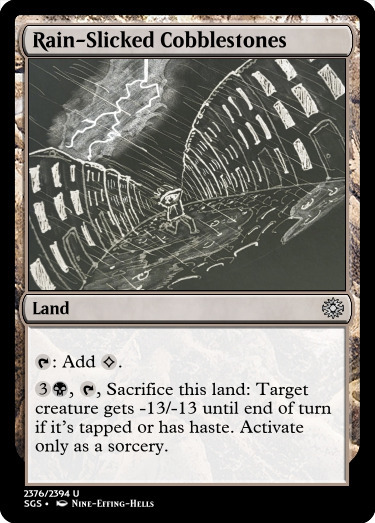
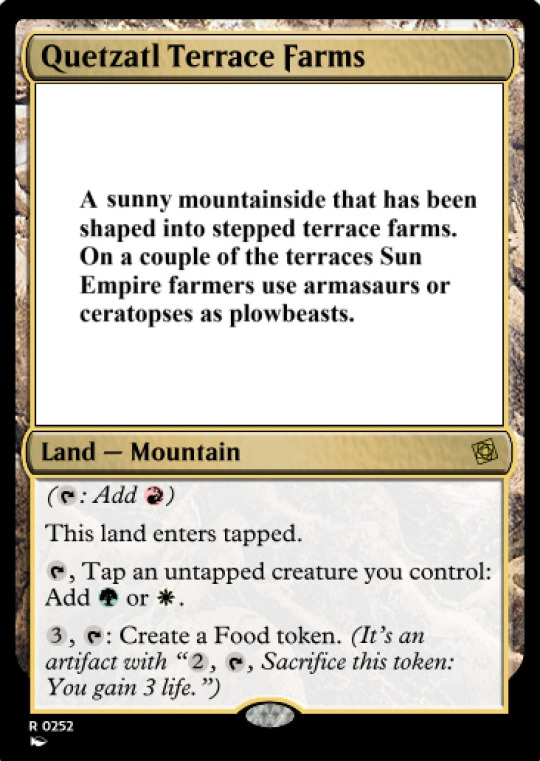
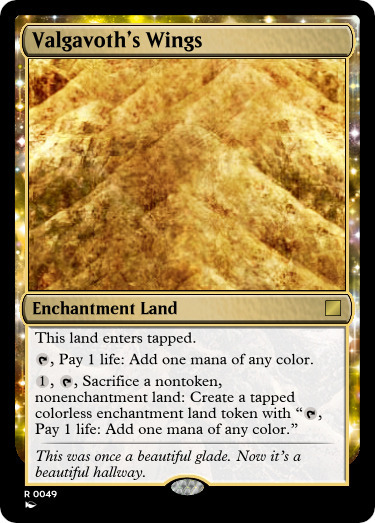
Our runners-up this week are @nine-effing-hells, @reaperfromtheabyss, and @sparkyyoungupstart!

@nine-effing-hells — Rain-Slicked Cobblestones
Removal lands, how we love the. I imagine that this could be part of a cycle in a noir setting, where each land has a sacrifice punisher effect. -13/-13 is substantial, but at the cost of a land, and it's a great threat to leave up. I think that Battle for Zendikar did a similar cycle of lands, and those were awesome for limited IIRC, though some more than others. This one is pretty great, a threat to catch someone unawares. Black caring about tapped creatures is old-school but in a good way, and the -13/-13 is another callback that takes out some of the largest stuff but in a flavorful way, and I think is under-utilized a lot of the time. Indestructible is a heck of an ability. I wonder how necessary the sorcery clause is on this one, honestly, especially considering that the flavor implies something a little speedier.
And my goodness, the flavor of this card is phenomenal. I'll be honest on top of it: the art is gripping me in a way that makes me ask: where the heck have you been hiding this from us? I love this sketch and it makes me want to go back to New Capenna, but in a less glitz-and-glamor sense and more of a gritty demonic horror sense. Wouldn't that be phenomenal? Something that makes you slip and crack your head on the stones, something that's definitely an accident, something that's definitely not the result of sinister forces making you pay for snitching, and that's what snitches get... Like, come on, it's so cool! This card's got an insular, claustrophobic vibe that trips up those unaware, and you really executed the whole presentation in a way that makes me smirk into my glass of scotch. Except not, because it's nine in the morning and I gotta drive today.

@reaperfromtheabyss — Quetzatl Terrace Farms
There were a few lands that worked with Food this week, but ultimately, I think that this one enamors me the most. As a fetchable utility land, it's pretty powerful, and I might even suggest that the Food-making ability have some manner of restriction (also tapping a creature? Activating only if you have tapped creatures?) to ensure that you don't get a wild amount of token value; Fountainport has already shown us how wild that can be. Color identity would also suggest that this "Mountain" should have some utility outside of being a mono-red lifegain land, and if I had any real mechanical qualms, that would be it. Limited would devour this thing (no pun intended) as a table-turning control piece with the amount of life you could stall out with each turn. If you imagine this as a colorless zero-cost permanent that entered tapped but had "{5}, T: You gain 3 life"—you see what I mean? It's an interesting balance question.
It's the way that this land comes to life that really gets me. They cut into the mountain and they make food—it's perfect. Harvesting life, the heart of civilization, a people in their element... I think this is a beautiful execution of the prompt. I love how you got the colors of the Sun Empire and the dinosaur connection and turned it into a land that makes sense, not necessarily for the associated mechanics, but for the feeling of the people that would live on that land and harvest it. That's the coolness of this, isn't it, the fact that you can demonstrate an entire other part of Magic's lore, not through a magic-strewn battlefield necessarily, but through the ways in which the world is made more whole. It's quite interesting to me.

@sparkyyoungupstart — Valgavoth's Wings
Mechanically, of course, this card is a pretty grotesquely fun way to trigger enchantments entering every turn, provided that you're willing to sacrifice your lands. I know that some players at our LGS are land afficionados, and Crucible/Ramunap plus everything here...yeesh. It's awesome, really, because they're not untouchable and a single Paraselene will make things fairly miserable if you overreach, but isn't that the point of that fragility, somewhat? The sacrifices that you make end up biting you in the end. And maybe they turn your lands into Mana Confluence. I mean, that alone is pretty wild, isn't it? Mana Confluences every turn at the cost of a land makes fixing negligible, but the eventual cost wears away at you. Is it worth the Eerie/Constellation triggers? That's for the Enchantress player to decide. It's pretty cool.
Admittedly Duskmourn was a pretty cool concept as well, at least to start. I'll withhold my opinions on cheerleaders and phones later, but regardless, the name of this land? Perfect. Like, that alone is exactly the kind of sinister encompassing that was meant to be shown throughout the story, that spreading terror, that strange and sinister warping of the world. This card makes the player feel, in some way, that they're getting the demon's power by way of utilizing their lands, turning them into semi-everywheres, turning them into horrible mirrors of what was once, as the flavor text puts it, a beautiful glade. It's the two-sentence structure of the FT that kinda stumbles me, honestly. "Once a beautiful glade, now an endless hallway." could've worked fine, or something along those lines, but I feel that it eschews poesis for something that tries to be malevolent? I don't think it's quite there, but the strength of the land saves it for sure.

We've got a lot of work to do today at the shop, but I'll commentate as we get there <3 Thank you all once more for your entries!
@abelzumi
#mtg#magic the gathering#custom magic card#inventor's fair#commentary#runners up#flavorful land contest
9 notes
·
View notes
Note
tell me things about moritte of the frost ? making a magic oc and she might be integral to her backstory so id love to hear anything you know
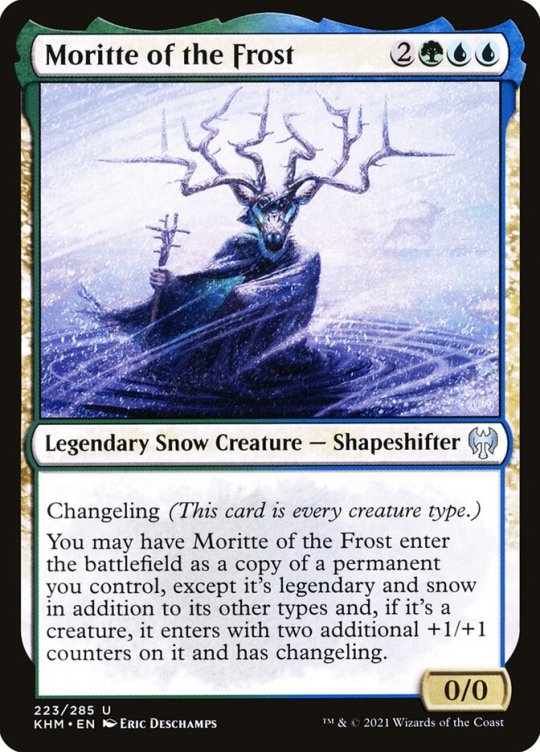
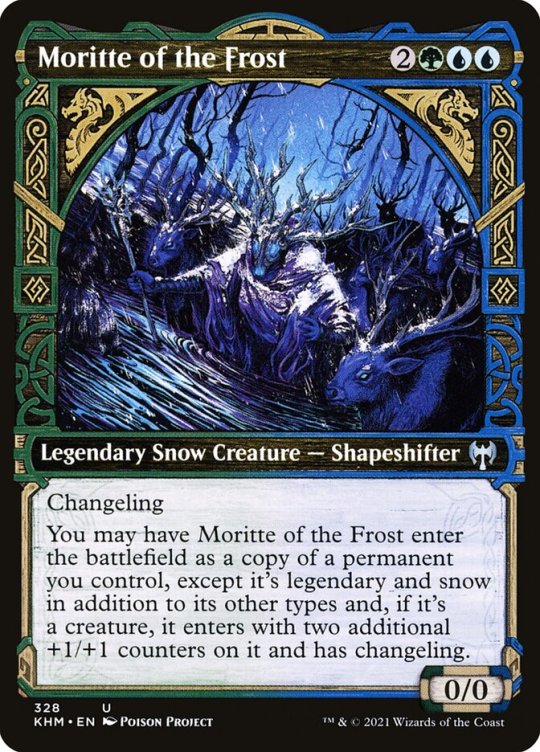
Ooooh, I love OCs!! Especially those related to Kaldheim and Littjara! Excited to see what you make 👀
Unfortunately I can't give you too much in the way of canon information. This is her bio in the Legends of Kaldheim article:
Moritte is an enigma. A shapeshifter from Littjara, she was born a Gladewalker. While many grown-up shapeshifters leave Littjara to explore the realms, Moritte wanted more knowledge. To reach that end, she took the form of a young Covewalker. Living among the Covewalkers, Moritte absorbed all their knowledge and secrets before vanishing into the mists. She now wanders the realms, the most knowledgeable shapeshifter of all, seeking the solutions to new unanswered questions.
It's vague, I expect delibrately so, but that's a little frustrating when you want actual details. I wrote a more in-depth post about expanding Littjara and changeling lore a while back, which might help if you're looking for headcanon inspiration.
As to the "knowledge" Moritte seeks, I'm inclined to believe it is cosmological, since that's a major part of Kaldheim's functioning--the way realms are formed, what happens to them when they break off the tree (they become planes!), and how Cosmos monsters are born. As a creature especially attuned to aether and the Cosmos, Moritte learning more about Kaldheim cosmology would also mean deepening her knowledge about herself.
Perhaps her quest for all-encompassing knowledge leads her to a revelation about the Multiverse even before the Phyrexian invasion forces everyone to be very, very aware of it. It might even entangle her with forces far beyond her comprehension. Namely, the Eldrazi. After all, what are Eldrazi but much larger Cosmos monsters? Wouldn't she want to find out?
After March of the Machine, I am almost positive that Moritte has left Kaldheim, traveling to learn the lore of other planes. (I know it very likely does not work like this but it would also be funny if all changelings were now planeswalkers, because of how Kaldheim cosmology works.) Some fun places for her to be: Arcavios for its repository of knowledge in Strixhaven, Kamigawa for its overlap of mortal and spirit realms, Zendikar for its history of entanglement with the Eldrazi titans.
I have correctly predicted major canon at least twice with my Kaldheim posts and I'm still riding that power trip a little bit.
33 notes
·
View notes
Text
I think one of my favorite parts of MTG lore is the way certain things can exist on multiple planes but be entirely different on different planes. Like take Vampires
On the gothic horror plane of Innistrad, vampires are your generic European Dracula type, while in Ixalan they're colonialist legionnaires modeled after conquistadors.
The origin and nature of vampirism changes from plane to plane too. Vampires on Innistrad were created when a demon tricked Sorin's grandpappy into creating the plague with blood magic, vampirism on Zendikar are the result of Eldrazi bullshit, and Ixalan vampires were made by... catholicism.
5 notes
·
View notes
Text
so this is a bit random for my blog but ive been dredging up my old magic the gathering hyperfixation because of friendgroups that play EDH and i had some random thoughts
ive always clicked weirdly well with the red/white color pairing but the reasons have shifted over time
and ive had this nagging brainworm that
magic as a whole is doing RW wrong.
allow me to explain
fair warning: this is going to get a bit political, a bit philosophical, and very strongly informed by who i am as a person
so
the core axiom here is that human nature in the absence of external factors is inherently good and altruistic. we know this because we are social creatures, and the fundamental basis of early social structures is coming together for mutual benefit. oppressive systems and harsh upbringings can and do quash this in favor of learned hostility and abusiveness but that core is always there. it’s why redeeming the villain is such a common fictional trope - if it wasn’t possible to change and grow and deconstruct learned harmful behaviors we wouldn’t write about it nearly as much now would we
magic as an ur-setting recognizes this to some extent. we see snippets of the kindness of strangers in Innistrad even amidst the horrors and the distrust and the paranoia, we see the selfless unity against the Eldrazi on zendikar drawing in all five colors of the pie, we see countless other examples throughout the planes
now, what does this axiom mean in the context of the color philosophies of red and white?
simple
red and white are not enemies at all
red is about freedom and impulsivity and emotion
white is about peace and justice and selflessness
both of those are deeply emotional, deeply raw, deeply human ideas!!
and the intersection of those ideas isn’t a controlling power structure, it’s compassion
and compassion is hardly oppositional - it’s cooperative and synthesistic by its very nature, it’s a harmonization of what those two colors are!
now admittedly this is where my perspective as an audhd trans girl comes in. i’m someone that the world’s power structures reject, someone that doesnt fit the status quo, someone who’s constantly shoved into boxes that i don’t fit by people more powerful than me. and i have kind of a thing for the color aesthetic of Boros, so trying to turn something i like aesthetically into something that meshes with and permits and supports who i am is a reasonable bias to assume
but i still feel like there’s a core truth to be considered here
games are a form of art; there’s plenty of evidence i think that the people making Magic realize this. but that drags in the corollary that all art is political. all art says something about the world, about the systems we live in. and what does the Boros say? that combining the philosophies of freedom and selflessness is a contradiction and leads to yet another oppressive power structure. it’s a subtly anti-revolutionary, status-quo perspective that could be done far better
more importantly, it’s eschewing that compassion
boros is a police state and a military structure, one that exists to enforce rules and make demands and enact violence
it’s not an institution of compassion
and frankly no top-down power structure can be, not at a systematic level
so, what would doing red-white right look like in my view?
pretty simple: it would be a bottom-up portrayal of the color pair. one where the defiance of red and the justice of white stand in opposition to an existing power structure, one where the righteous fury of the downtrodden feeds into both colors’ fundamental natures and binds them together
so uh
yeah
thank you for coming to my ted talk
okay so a couple final disclaimers
- the last time i seriously caught up with mtg lore was around Magic Origins, with sporadic involvement stretching out to Guilds Of Ravnica. i’m not terribly familiar with any of the expressions of RW since then, and i’m mostly focused on the lens of Boros specifically because they’re the faction that got me into the color pair. if there have since been counterexamples i will gladly accept infodumps, new blorbos to build TTS EDH decks around are always welcome (winota my beloved) (the cat ears,,, 🥺🥺🥺). this also extends to my understanding of magic’s development and philosophy as a whole, so if it seems like arguing from a Magic-cultural context that’s several years behind the curve uhhh yeah that’s probably why
- i’ll admit i’m not tremendously well-read in terms of firsthand literature in terms of leftist/anarchist theory, queer theory, or Magic’s color philosophies, and so most of my information is secondhand - if i’ve grossly misunderstood something feel free to explain (although if you’re going to be a TERF in the reblogs about it you can kindly go shit yourself)
- i mean no ill will and make no particular demands or anything towards the writers themselves who came up with boros or the ideas they’ve expressed through the faction/color-identity; it takes a certain perspective to notice these things and assuming people will just Get It is unreasonable, and i’m not here to like. Annoyingly Insist that the game i have a tangentialhyperfixation on conform to My Vision Of What It Should Be
and uhhh yeah! trans rights are human rights, free palestine, and wishing all capitalists a very fuck you!
sierra out, roll credits
35 notes
·
View notes
Text
So I just read the Planeswalker's Guides to Aetherdrift° and I went from "Meh racing set" to "Oh shit there's so much WORLDBUILDING I'm stoked". Like Amonkhet and Avishkar got so much development and Muraganda got a ton of new lore. In particular:
Avishkar:
• I feel like the Indigo Revolution and The Assembly did a good job as a hook for making Avishkar a lot more interesting than it was in og Kaladesh block, detailing the endemic problems with their attempts at a classless society? Fascinating. Also their connections to the rest of the multiverse and trying to rival Ravnica's influence? It adds a lot more to the plane that really revitalizes it
Amonkhet
• I'm so normal about Amonkhet. There's so much interesting stuff about the cooperation and relationships between the living and undead in Naktamun and beyond, the obstinance of the Monarchs, the looming threat of the Chitinn Court? ALSO TWO NEW GODS????
Muraganda:
• Muraganda is really interesting. Like all the different factions? Sentient dinosaurs and gorillas? Scar witches making pacts with Eldritch horrors? Moons falling from the sky after magic is discovered? It's like you rolled together Zendikar, Ixalan and Naya then poured them into one of those 1950's jello moulds
° https://magic.wizards.com/en/news/feature/planeswalkers-guide-to-aetherdrift-part-1
9 notes
·
View notes
Text
the mtg au only gets so much harder from fable as bolas but we make attempts (take so many pinches of salt, take multiple fistfuls of salt with all the words i say . ive been into magic lore for less than a week)
athena as chandra and jamie as nissa
havent read all of chandras lore yet but, yknow pyromancer and her wiki says shes passionate, impulsive but "she also recognizes the volatile nature of her inner fire" replace inner fire with destruction powers and boom c!athena probably
and nissa revane my GIRL !! (while i havent finished reading every single story shes ever been in yet) her whole bit is being connected to her home plane, while thats technically more plants and the earth itself i didnt think shes mom coded enough to say momboo. so i say bruin instead, and specifically bruin not c!jamie because they got more of that deltavera in they bones . honestly you might even be able to argue that ayasha (the elemental companiont nissa summons, "the awakened world") could be momboo in some way or another cause . thats literally the world of zendikar
then slightly more of a stretch and also i was busy playing stardew when i watch the video on lilianna so i only got about half of that into my brain
icarus morningstar as lilinna vess because hear me out . necromancy is something icarus would TOTALLY be obsessed with if it existed in an accesible means in fable and if we take her whole contract with bolas in war of the spark and her then betrayal i think it could *kind of* fit a little bit . also i think she had a thing where she wanted to try and bring her brother back from the dead so if we just replace that with haley .
(this could mean that centross is jace beleren which honestly, dont think hes smart enough for that , and from what ive read jace is NOT a fighter but i also put centross as penelope in the epic au and hes not smart enough to be her her either . so)
alternatively (probably if ic is not lilianna) rae could be jace beleren . really freaking smart, not a fighter, mind powers, gets tricked by bolas into releasing a terrible monster from a prison, blue
i was also distracted when i watched jace's lore video but i read like 3 lines of his wiki and im reading the eldrazai return story so i kinda have somewhat of an understanding of his character. so im actually completely right in every way
#i dont know if anyone else in the fable fandoms been infected with magic brainrot#but i have#and now im gonna make it all of your problems#if none of you even know the lore then you cant dispute that im 100% right /silly#this is NOT going to be my last post about this so im just gonna make it tag straight away#fable smp mtg au#underscore.text#fable smp#fsmp
19 notes
·
View notes
Note
who crafted the back brace for tantum?
Oooh this one also has a bit of a story attached. I’m always hyped to tell though :)
Pirates’ Roost spoilers and mentions of abuse and cancer below the cut
The short answer is a woman named Saheeli Rai, who I’ve never actually brought up before. She’s an artificer (metal mage) who’s from the Sun Empire as far as anyone in the Pirates’ Roost knows, and she’s the resident mage/wife of their Warrior-Poet (important religious/cultural figure) Huatli
The longer answer of how she got involved in this… well, Tatum and crew went to the Sun Empire to help Tatum’s brother Apatli, who had cancer. When they came to bring him back, Tatum got arrested for being a deserter and their very nasty mentor figure who mistreated them in the past showed up to offer to bring them back into the fold
Apatli wasn’t too thrilled and decided to essentially trick everyone into thinking the suns were mad at this decision by summoning a storm to blot out the sun. Saheeli suspected it wasn’t in fact the suns willing this and tracked Apatli down to ask what he wanted. She agreed to try to get Tatum released
Huatli and Saheeli ended up having a talk with Tatum where Tatum explained why they deserted (abuse from aforementioned mentor figure and no one willing to help them). Huatli used her authority as Warrior-Poet to have them freed, and Saheeli made them the brace as an attempt at remuneration for everything the Sun Empire had done to them
Thanks for the ask! I hope that’s a good explanation. As always, I’m game for any more questions anyone has :)
(Also, if you know magic lore and are starting to think this doesn’t quite line up, Pirates’ Roost is canon-divergent from Zendikar Rising)
8 notes
·
View notes